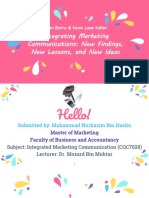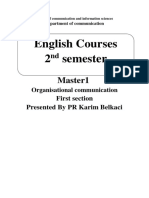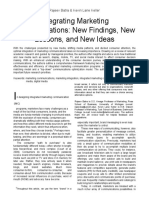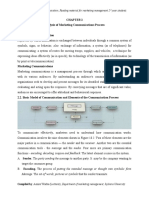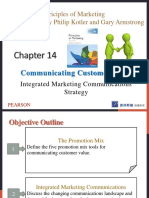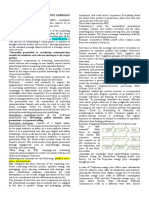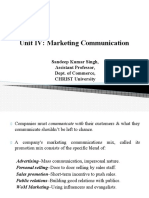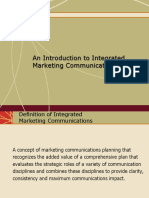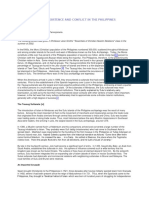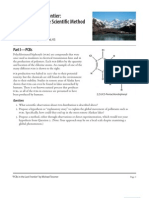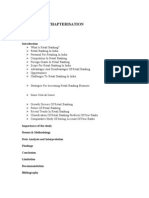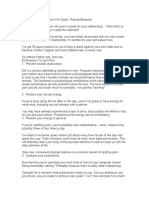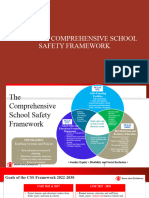MIP Module 5
Uploaded by
devayudthdeyytMIP Module 5
Uploaded by
devayudthdeyytMARKETING IN PRACTICE V SEM BBA
THIS IS FOR PRE READING AS QUESTIONS IN THE EXAM WILL BE PRACTICAL AND APPLICATION BASED
Module 5
Integrated Marketing Communication (IMC)
Syllabus Coverage:
Role of IMC, Communication Process Models, Communication Mix including Public Relations,
Understanding and developing a Brand Key model. Designing and Managing Marketing
Campaigns, Event Management.
Marketing Communication
Modern marketing calls for more than developing a good product, pricing it attractively, and
making it accessible. Companies must also communicate with their present and potential
stakeholders and the general public. For most marketers, therefore, the question is not whether
to communicate but rather what to say, how and when to say it, to whom, and how often.
Consumers can turn to hundreds of cable and satellite TV channels, thousands of magazines and
newspapers, and millions of Internet pages. They are taking a more active role in deciding what
communications they want to receive as well as how they want to communicate to others about
the products and services they use. To effectively reach and influence target markets, holistic
marketers are creatively employing multiple forms of communications.
Marketing communications are the means by which firms attempt to inform, persuade, and
remind consumers—directly or indirectly—about the products and brands they sell. In a sense,
marketing communications represent the voice of the company and its brands; they are a means
by which the firm can establish a dialogue and build relationships with consumers. By
strengthening customer loyalty, marketing communications can contribute to customer equity.
Marketing communications also work for consumers when they show how and why a product is
used, by whom, where, and when. Consumers can learn who makes the product and what the
company and brand stand for, and they can get an incentive for trial or use. Marketing
communications allow companies to link their brands to other people, places, events, brands,
experiences, feelings and things. They can contribute to brand equity—by establishing the brand
in memory and creating a brand image—as well as drive sales and even affect shareholder value.
Integrated Marketing Communication (IMC)
Many companies still rely on only one or two communication tools. This practice persists in spite
of the fragmenting of mass markets into a multitude of minimarkets, each requiring its own
approach; the proliferation of new types of media; and the growing sophistication of consumers.
The wide range of communication tools, messages, and audiences makes it imperative that
companies move toward integrated marketing communications. Companies must adopt a “360-
STRICTLY FOR PRIVATE CIRCULATION AT JU-CMS 1
MARKETING IN PRACTICE V SEM BBA
THIS IS FOR PRE READING AS QUESTIONS IN THE EXAM WILL BE PRACTICAL AND APPLICATION BASED
degree view” of consumers to fully understand all the different ways that communications can
affect consumer behavior in their daily lives.
Integrated Marketing Communication(IMC) is the coordination and integration of all marketing
communication tools, avenues and sources, within a company into a seamless program that
maximises consumer impact at minimal cost.
The American Marketing Association defines Integrated Marketing Communications (IMC) as “a
planning process designed to assure that all brand contacts received by a customer or prospect
for a product, service, or organization are relevant to that person and consistent over time.” This
planning process evaluates the strategic roles of a variety of communications disciplines—for
example, general advertising, direct response, sales promotion, and public relations—and
skillfully combines these disciplines to provide clarity, consistency, and maximum impact through
the seamless integration of messages.
Media coordination can occur across and within media types, but marketers should combine
personal and non-personal communications channels through multiple-vehicle, multiple-stage
campaigns to achieve maximum impact and increase message reach and impact.
Role and Significance of IMC
In the absence of integration, different stakeholders in the company will end up sending out
conflicting signals on the brand, to the consumers
To address these issues, companies are adopting the concept of Integrated Marketing
Communication
Under IMC, a company integrates and coordinates its many communication channels to
deliver a clear, consistent and compelling message about the organisation and its brands
The Communication Process Model
Marketers should understand the fundamental elements of effective communication. A macro-
model of marketing communication is considered to be extremely useful for the marketers.
STRICTLY FOR PRIVATE CIRCULATION AT JU-CMS 2
MARKETING IN PRACTICE V SEM BBA
THIS IS FOR PRE READING AS QUESTIONS IN THE EXAM WILL BE PRACTICAL AND APPLICATION BASED
Sender ENCODING Message Decoding Receiver
Media
Noise
Feedback Response
Sender’ Receive
s field r’s field
of of
experie experie
Two represent the major parties— sender and receiver. Two represent the major tools—message
and media. Four represent major communication functions—encoding, decoding, response, and
feedback. The last element in the system is noise, random and competing messages that may
interfere with the intended communication.
Senders must know what audiences they want to reach and what responses they want to get.
They must encode their messages so the target audience can decode them. They must transmit
the message through media that reach the target audience and develop feedback channels to
monitor the responses. The more the sender’s field of experience overlaps that of the receiver,
the more effective the message is likely to be. Considering factors such as selective attention,
distortion, and retention play a vital role in an effective communication process.
The Marketing Communication Model can be explained by considering the following print
advertisement:
STRICTLY FOR PRIVATE CIRCULATION AT JU-CMS 3
MARKETING IN PRACTICE V SEM BBA
THIS IS FOR PRE READING AS QUESTIONS IN THE EXAM WILL BE PRACTICAL AND APPLICATION BASED
Sender : The party sending the message to another party.
In this case: Mitsubishi Motors.
Encoding : The process of putting thought into symbolic form.
In this case: In this case the agency assembles words and illustrations into an ad which
conveys the message.
Message : The set of symbols the sender transmits .
In this case: In this case the actual ad.
Media : The communication channels through which the message moves from the sender to
the receiver .
In this case: In this case magazines or newspapers used.
Decoding : The process by which the receiver assigns meaning to the symbols encoded by the
sender.
Receiver : The party receiving the message sent by the other party.
In this case: High Net-Worth Individuals, Auto enthusiasts, Rally drivers
Response : The reaction of the receiver after being exposed to the ad – many responses
possible, from asking for information to actually checking price, to asking for a test drive.
Feedback : The part of receiver’s response communicated back to the sender – Research
feedback, consumer or trade feedback.
Noise : The unplanned static or distortion during the communication process, which results
in the receiver getting different message than the one the sender sent – Missed the ad,
interpreted differently.
Developing Effective Communication
STRICTLY FOR PRIVATE CIRCULATION AT JU-CMS 4
MARKETING IN PRACTICE V SEM BBA
THIS IS FOR PRE READING AS QUESTIONS IN THE EXAM WILL BE PRACTICAL AND APPLICATION BASED
It is very important to have an effective communication for the success of any marketing activities
and business. The following illustration shows the six steps in developing effective
communications. We begin with the basics: identifying the target audience, determining the
objectives, designing the message, selecting the channels/media, source, and collecting the
feedback.
Identifying
the TA
Collect Comn
feedback Objectives
Select
Message
message
design
source
Choosing
Media
1. Identify the Target Audience
The process must start with a clear target audience in mind: potential buyers of the
company’s products, current users, deciders, or influencers, and individuals, groups,
particular publics, or the general public. The target audience is a critical influence on the
communicator’s decisions about what to say, how, when, where, and to whom.
Though we can profile the target audience in terms of any of the market segments, it’s often
useful to do so in terms of usage and loyalty. Is the target new to the category or a current
user? Is the target loyal to the brand, loyal to a competitor, or someone who switches
between brands? If a brand user, is he or she a heavy or light user? Communication strategy
will differ depending on the answers. We can also conduct image analysis by profiling the
target audience in terms of brand knowledge.
2. Determine the Communications Objectives
As we showed with Pottsville College, marketers can set communications objectives at any
level of the hierarchy- of-effects model. John R. Rossiter and Larry Percy identify four possible
objectives, as follows:
1. Category Need: Establishing a product or service category as necessary to remove or satisfy
a perceived discrepancy between a current motivational state and a desired motivational
STRICTLY FOR PRIVATE CIRCULATION AT JU-CMS 5
MARKETING IN PRACTICE V SEM BBA
THIS IS FOR PRE READING AS QUESTIONS IN THE EXAM WILL BE PRACTICAL AND APPLICATION BASED
state. A new-to-the-world product such as electric cars will always begin with a
communications objective of establishing category need.
2. Brand Awareness: Fostering the consumer’s ability to recognize or recall the brand within
the category, in sufficient detail to make a purchase. Recognition is easier to achieve than
recall - consumers asked to think of a brand of frozen entrées are more likely to recognize
Stouffer’s distinctive orange packages than to recall the brand. Brand recall is important
outside the store; brand recognition is important inside the store. Brand awareness provides
a foundation for brand equity.
3. Brand Attitude: Helping consumers evaluate the brand’s perceived ability to meet a
currently relevant need. Relevant brand needs may be negatively oriented (problem removal,
problem avoidance, incomplete satisfaction, normal depletion) or positively oriented
(sensory gratification, intellectual stimulation, or social approval).Household cleaning
products often use problem solution; food products, on the other hand, often use sensory-
oriented ads emphasizing appetite appeal.
4. Brand Purchase Intention: Moving consumers to decide to purchase the brand or take
purchase-related action. Promotional offers like coupons or two-for-one deals encourage
consumers to make a mental commitment to buy. But many consumers do not have an
expressed category need and may not be in the market when exposed to an ad, so they are
unlikely to form buy intentions. In any given week, only about 20 percent of adults may be
planning to buy detergent, only 2 percent to buy a carpet cleaner, and only 0.25 percent to
buy a car.
3. Designing the Message for Communication
Formulating the communications to achieve the desired response requires solving three
problems: what to say (message strategy), how to say it (creative strategy), and who should
say it (message source).
MESSAGE STRATEGY In determining message strategy, management searches for appeals,
themes, or ideas that will tie in to the brand positioning and help establish points-of-parity or
points-of-difference. Some of these may be related directly to product or service
performance (the quality, economy, or value of the brand), whereas others may relate to
more extrinsic considerations (the brand as being contemporary, popular, or traditional).
CREATIVE STRATEGY Communications effectiveness depends on how a message is being
expressed, as well as on its content. If a communication is ineffective, it may mean the wrong
message was used, or the right one was poorly expressed. Creative strategies are the way
marketers translate their messages into a specific communication. We can broadly classify
them as either informational or transformational appeals.
4. Choosing the Communications Media/Channels
STRICTLY FOR PRIVATE CIRCULATION AT JU-CMS 6
MARKETING IN PRACTICE V SEM BBA
THIS IS FOR PRE READING AS QUESTIONS IN THE EXAM WILL BE PRACTICAL AND APPLICATION BASED
Selecting an efficient means to carry the message becomes more difficult as channels of
communication become more fragmented and cluttered. Communications channels may be
personal and non-personal. Within each are many sub-channels.
Personal communications channels let two or more persons communicate face-to-face or
person-to-audience through a phone, surface mail, or e-mail. They derive their effectiveness
from individualized presentation and feedback and include direct and interactive marketing,
word-of-mouth marketing, and personal selling.
Non-personal channels are communications directed to more than one person and include
advertising, sales promotions, events and experiences, and public relations. Much recent
growth has taken place through events and experiences. Events marketers who once favored
sports events are now using other venues such as art museums, zoos, and ice shows to
entertain clients and employees.
5. Message Source Messages delivered by attractive or popular sources can achieve higher
attention and recall, which is why advertisers often use celebrities as spokespeople.
Celebrities are likely to be effective when they are credible or personify a key product
attribute. Statesman-like Dennis Haysbert for State Farm insurance, rugged Brett Favre for
Wrangler jeans, and one-time television sweetheart Valerie Bertinelli for Jenny Craig weight
loss program have all been praised by consumers as good fits. Celine Dion, however, failed to
add glamour—or sales—to Chrysler, and even though she was locked into a three-year, $14
million deal, she was let go. Ozzy Osbourne would seem an odd choice to advertise “I Can’t
Believe It’s Not Butter” given his seemingly perpetual confusion.
What is important is the spokesperson’s credibility. The three most often identified sources
of credibility are expertise, trustworthiness, and likability. Expertise is the specialized
knowledge the communicator possesses to back the claim. Trustworthiness describes how
objective and honest the source is perceived to be. Friends are trusted more than strangers
or salespeople, and people who are not paid to endorse a product are viewed as more
trustworthy than people who are paid.
Likability describes the source’s attractiveness. Qualities such as candor, humor, and
naturalness make a source more likable. The most highly credible source would score high on
all three dimensions—expertise, trustworthiness and likability.
6. Collecting the Feedback
It is always important to collect the feedback from customers, distribution channel members
such as wholesalers, distributors, dealers and retailers as well as from company’s own sales
people to know the effectiveness of marketing communication and accordingly the
advertisement campaign can be modified, message can be redesigned if necessary and
STRICTLY FOR PRIVATE CIRCULATION AT JU-CMS 7
MARKETING IN PRACTICE V SEM BBA
THIS IS FOR PRE READING AS QUESTIONS IN THE EXAM WILL BE PRACTICAL AND APPLICATION BASED
communication channels can be chosen. The feedback forms the part of measuring and
evaluating the effectiveness of marketing communication activities.
Communication Mix
The marketing communication mix or simply referred to as communication mix is a combination
of different communication channels which are put to use in communicating the marketing
message to the target audience effectively and efficiently. There are five types of commonly
used marketing communication channels which forms communication mix.
1. Advertising:
Any paid form of non- personal presentation and promotion of ideas, goods, or services by
an identified sponsor via print media (newspapers and magazines), broadcast media (radio
and television), network media (telephone, cable, satellite, wireless), electronic media
(audiotape, videotape, videodisk, CD-ROM,Web page), and display media (billboards, signs,
posters).
Advertising Executions:
Slice of life – Shows one or more typical people, using the product in normal setting
Lifestyle – Shows how a product fits in with a particular lifestyle
Fantasy – Creates a fantasy around the product or its use
Mood or image – Builds a mood or image around the product like beauty or love
Musical – Where the core idea is conveyed through music or songs
Technical expertise – The company has expertise in making the product
Scientific evidence – Used to show that a brand is better than others
Testimonial or endorsement– Uses believable or likeable source endorsing the product
STRICTLY FOR PRIVATE CIRCULATION AT JU-CMS 8
MARKETING IN PRACTICE V SEM BBA
THIS IS FOR PRE READING AS QUESTIONS IN THE EXAM WILL BE PRACTICAL AND APPLICATION BASED
Advertising Evaluation:
An advertising campaign undergoes a pre-test and post-test to understand
comprehension, likeability and attitude change scores
Evaluation needs to be two fold. Evaluation of advertising as well as evaluation of sales
effects of advertising
Sales effect is often harder to measure than advertising as sales is dependent on a lot
more factors than just advertising
2. Sales Promotion:
A variety of short-term incentives to encourage trial or purchase of a product or service
including
Consumer promotions (Samples, coupons, and premiums)
Trade promotions (Advertising and display allowances)
Business promotions (Incentives, foreign tour for doing certain volume of business)
Sales force promotions (contests for sales reps).
3. Public Relations:
A variety of programs directed internally to employees of the company or externally to
consumers, other firms, the government, and media to promote or protect a company’s
image or its individual product communications.
Press relations – Creating and placement of newsworthy information in media to attract
attention
Product publicity – Publicizing specific products
Public affairs – Creating, building and maintaining national or local community relations
Lobbying – Building & maintaining relations with legislators and government officials to
influence legislation and regulation
Investor relations – Maintaining relationship with shareholders and the financial
community
Development – Public relations with donors or members of not-for-profit organisations
to get financial or volunteer support
4. Personal Selling:
It is also called as Zero-Level Distribution Channel. It is the Face-to-face interaction with one
or more prospective purchasers for the purpose of making presentations, answering
questions and procuring orders.
People who sell go by many names: Salespeople, Sales Representatives, Key account
executives, Sales consultants, agents, Account development representatives etc. At one level
STRICTLY FOR PRIVATE CIRCULATION AT JU-CMS 9
MARKETING IN PRACTICE V SEM BBA
THIS IS FOR PRE READING AS QUESTIONS IN THE EXAM WILL BE PRACTICAL AND APPLICATION BASED
a salesperson can be just an order taker and at the other extreme an order getter who needs
to not just sell but build relationships Advertising is one way non-personal communication.
Personal Selling is however two-way, personal communication between salesperson and
individual customers
5. Direct Marketing:
It is nothing but communicating directly with the target audience through a personalized
content or message and medium.
Tele or telephone marketing - Use the telephone to sell directly to customers
Catalogue marketing - Marketing through print, video or e - catalogues that are mailed
to select customers, made available in stores
Direct mail marketing - Sending an offer, announcement, reminder to a person at a
particular address
Direct response TV marketing - Includes direct response TV ads, Infomercials and home
shopping channels
Online marketing - Marketing offers through the use of the internet
Personal Selling - Salesperson uses skills for building personal relationships with those
involved in a purchase decision
Merits & Demerits of IMC
Merits of IMC
Improves Trustworthiness: Consistent reliability and reliable consistency helps your
customers get to know and to trust you.
Improves Brand Recognition: Looking the same way, speaking the same way and giving the
same clear message at every touch point is guaranteed to help customers recognise you
faster and more easily.
Focused Message: Instead of diluting your message by opting for a scattergun approach,
you’ll be focusing it and concentrating its effects, both on your customers and internally
within your organisation too.
Improvement in Budget Allocation: When everyone from your SEO genius to your social
media manager is focused on the same message and end goal, things get cheaper. Duplicated
efforts are less likely, transactional costs are minimised through standardised branding and
promotional collateral, and design and print costs will benefit from being scaled up.
Generates More Profit: There are plenty of case studies out there which show a direct benefit
to revenue from integrated customer journeys. In fact, in some cases, integrated marketing
has been shown to produce double the sales value year on year.
STRICTLY FOR PRIVATE CIRCULATION AT JU-CMS 10
MARKETING IN PRACTICE V SEM BBA
THIS IS FOR PRE READING AS QUESTIONS IN THE EXAM WILL BE PRACTICAL AND APPLICATION BASED
Caters to Customer’s Information Requirements: As we discussed earlier, customers are
crying out for information and consistency in marketing and shopping experiences, so why
on earth wouldn’t you give it to them? Chances are many of your competitors are not giving
it to them either, so you’ll be a step ahead if you take the lead in this initiative.
Demerits of IMC
It’s not easy: It takes a shift in mindset to get integration really working for you. You’ll need
to plan meticulously in order to get it right, and will need to stop thinking about different
types of marketing as different ‘departments’ or teams, because it’s all one big animal now.
Needs Good Background work: But Miss, the dog ate it. No, really, you have to crunch some
numbers to get this to work, largely to find out who your audience are and what motivates
them. Without this knowledge, you’ll struggle to find a message that really resonates and
motivates in the way you need it to.
Teamwork is Essential: Does your design department tend to live a very separate life from
your web analytics team? Do your CRM specialists barely nod hello to your SEO team on a
day to day basis? Well, all that needs to change, because you can only achieve truly integrated
marketing when you’re running a truly integrated team. This may require some alterations to
your operations, or even to the layout of your office, but don’t be afraid; together you are
stronger!
Measurements can be challenging: Because you’re working across so many channels with
this one mega-campaign, measurements of success and data points to consider are about to
get much more complicated. It’s all perfectly do-able, but you need to have agreed as a team
what successes look like before you start, so you can measure and recognise when you’ve
achieved a goal.
Brand Key Positioning
Brand Key is a marvelous model to use when trying to position a brand; it also allows you to
establish the areas that the brand may in fact need to work on to develop a more effective
communications strategy. This model is used in many different organisations.
STRICTLY FOR PRIVATE CIRCULATION AT JU-CMS 11
MARKETING IN PRACTICE V SEM BBA
THIS IS FOR PRE READING AS QUESTIONS IN THE EXAM WILL BE PRACTICAL AND APPLICATION BASED
1. Root Strengths:
The first step of the BrandKey looks at the original product, values and benefits that make the
brand so great, these aspects are the foundation on which you want to build a brand.
2. Competitive Environment:
The competitive environment looks at the market in which a brand competes as well as the
relative value the brand offers in that particular market.
3. Target:
Who is the brand targeting? What are these people like? What are their interests? Target
market is defined by consumers attitudes and values, not just their demographics.
4. Insight:
The main elements you gather about the target market and their needs. Your insights
ultimately guide your final outcome/executions.
STRICTLY FOR PRIVATE CIRCULATION AT JU-CMS 12
MARKETING IN PRACTICE V SEM BBA
THIS IS FOR PRE READING AS QUESTIONS IN THE EXAM WILL BE PRACTICAL AND APPLICATION BASED
5. Benefits:
The differentiating functional, emotional and sensory benefits that motivate a purchase.
Functional benefits are based on a products attributes that provide customers with
functional value.
Emotional benefits look at how a customer feels when purchasing or using a product-
how does the product influence them emotionally?
Sensory benefits deal with the way in which a product appeals to consumers senses.
6. Values, Beliefs & Personality:
What does the brand value? What does the brand stand for/ believe in? What kind of
personality does the brand have?
7. Reasons to Believe:
A brands ‘reason to believe’ is the proof that it offers to its consumers to substantiate its
benefits/ brand experience.
8. Discriminator:
The single most compelling and competitive reasoning for consumers to choose the brand
over its competitors.
9. Essence:
Refinement of the brand into a core idea or brand promise, the brand essence is the heart
and soul of the brand as it guides all brand actions.
In conclusion a BrandKey allows us to make a distinction between describing the current situation
of a brand and the future of a brand (their desired location- where the brand wants to go). It is
important to note that points 1-4 deal with the external factors of a brand and points 5-9 deal
with the internal factors influencing a brand.
Marketing Campaign
Marketing campaign is a systematic method consisting of a focused activity or set of activities for
both communicating with their market to reinforce their positioning and for customer
acquisition. Many marketing campaigns contain a comprehensive theme.
Since marketing campaign is a systematic activity, it has to be followed methodically step by step
without giving room for any error or ambiguity. The following are the seven steps in creating a
successful marketing campaign which is illustrated bellow.
STRICTLY FOR PRIVATE CIRCULATION AT JU-CMS 13
MARKETING IN PRACTICE V SEM BBA
THIS IS FOR PRE READING AS QUESTIONS IN THE EXAM WILL BE PRACTICAL AND APPLICATION BASED
1. Define the campaign goal
2. Evaluate the Campaign Climate
3. Chart the Course of Action
4. Campaign Budgeting
5. Choose the Influence Strategy
6. Message for Impact
7. Manage the Campaign
1. Defining the campaign goal:
What do you expect from your marketing campaign? What do you want to achieve out of this
marketing campaign? Before you even begin any of the work on your campaign you need to
set out and define your goals. Ensure that the goals you set for the individual campaign are
fully aligned and in keeping with the department as a whole. Your over-arching marketing
plan should cover all of your business activities, and while each campaign needs to be unique,
it needs to keep your central plan and its goals in mind.
2. Evaluate the campaign climate:
Once you clearly define your campaign goals, it’s time to evaluate the climate in which you’ll
deploy your outreach. When you understand what’s going on with your issue/theme,
competition or audience, you can plan to maximize the positives and strengthen any
weaknesses. Identify what’s already working in your favor and what obstacles might cause
your message to get lost or be misunderstood. Some questions to help you evaluate your
issue’s climate:
Is your theme active on the implementation agenda or stuck?
What is the current situation in the market around your theme/ issue?
Who are the competition and what is their agenda?
Who else is working on this issue/theme?
What current events or opportunities can you use to your advantage?
STRICTLY FOR PRIVATE CIRCULATION AT JU-CMS 14
MARKETING IN PRACTICE V SEM BBA
THIS IS FOR PRE READING AS QUESTIONS IN THE EXAM WILL BE PRACTICAL AND APPLICATION BASED
3. Chart the Course of Action:
Lay out the series of milestones that you must hit on your way to reach your goal. Ideally,
these steps should build off each other and indicate that your campaign is gaining
momentum. Focus these milestones on the desired outcomes, rather than the tactics
themselves. For example, if your campaign will reach out to local businesses to gain sponsors,
your milestone should not be pitching these business owners. Rather, it should be that you
reach your desired number of confirmed business partners for your cause.
4. Campaign Budgeting:
Budgeting can be a difficult process. Many companies just estimate, or base their budget on
last year’s spend. An estimate is better than nothing, but if you’ve defined your major
campaigns and needs, you can develop better numbers. You also use ROI to determine the
appropriate total budget for your marketing efforts.
5. Chose the influence Strategy:
Along with each step, understand the decision makers who will determine your success.
These may be voters, business partners, or public officials. Then, find out who will have the
most influence on these decision makers. These are the people you want to reach and
activate to help your initiative gain momentum. Warning: avoid naming broad groups such as
“the general public,” “voters” or “women.” Just as you did with your campaign goal, get very
specific about your influencers so you have a clear picture of the kind of person you need to
reach to achieve victory.
6. Message for Impact:
All campaigns benefit from a message platform that provides everyone in your organization
with a consistent positioning statement. Keep in mind that a message platform doesn’t need
to be rigid, nor does it need to be memorized, but it should provide the core concepts and
talking points to serve as a guide for your spokespeople. A good message platform includes
the following four points:
Explain the problem/need that currently exists or the situation that you are working to
change
Specify what your campaign is working to accomplish
Describe how you recommend addressing the need or problem, along with the with
specific actions that decision makers need to take
STRICTLY FOR PRIVATE CIRCULATION AT JU-CMS 15
MARKETING IN PRACTICE V SEM BBA
THIS IS FOR PRE READING AS QUESTIONS IN THE EXAM WILL BE PRACTICAL AND APPLICATION BASED
Explain the result that a campaign victory will have and how it solves the problem you
noted at the start
7. Manage the Campaign:
Once you outline the main tactics to achieve your goals, you still need to plan the day-to-day
details to get it done. Each assignment should have a deadline/timeline, owner, metrics
including outcomes, and a budget. When it comes to metrics, it’s important to think of ones
that lead to outcomes. Once your campaign is underway, don’t forget to celebrate the small
victories with your team to keep everyone motivated.
Event Management
Event management is the application of project management to the creation and development
of large-scale events such as festivals, conferences, ceremonies, weddings, formal parties,
concerts, or conventions. It involves studying the brand, identifying its target audience, devising
the event concept, and coordinating the technical aspects before actually launching the event.
Event management might be a tool for strategic marketing and communication, used by
companies of every size. Companies can benefit from promotional events as a way to
communicate with current and potential customers.
Event Manager should perform the following activities for running a successful event:
• Overall Event Designing
• Brand Building
• Marketing & Communication Strategy
• Audio-Visual Production
• Script Writing
• Logistics
• Budgeting
• Negotiation
• Client Service.
End of the Module – 5
Disclaimer: This Module notes has been compiled from various text books and reference books
as well as net based contents. This study support material is strictly for internal circulation
only within JU-CMS.
STRICTLY FOR PRIVATE CIRCULATION AT JU-CMS 16
MARKETING IN PRACTICE V SEM BBA
THIS IS FOR PRE READING AS QUESTIONS IN THE EXAM WILL BE PRACTICAL AND APPLICATION BASED
Practice Questions: Questions in the exam will be application based.
Section – A: 2 Marks Questions
1. What is marketing communications?
2. Expand IMC
3. Define Brand key.
4. What is the significance of communication mix?
5. What is advertising?
6. What is event management?
7. Define Public relations.
8. What is a marketing campaign?
9. Give any two roles of IMC.
10. What are the two important benefits of Advertising?
Section – B: 4 Marks Questions
1. Briefly explain the communication process model.
2. Write a short note on Event management.
3. Mention the contents of a marketing campaign.
4. Write down the merits of IMC.
5. Briefly explain the significance of IMC.
6. List down the demerits of IMC.
Section – C: 10 Marks Questions
1. Draw the brand key with relevant examples.
2. Draw the communication process with relevant examples.
3. Explain the communication mix with relevant examples.
4. Define communication Mix. Apply communication mix to any industry of your choice.
5. Brand key is a must for a brand. Comment
STRICTLY FOR PRIVATE CIRCULATION AT JU-CMS 17
You might also like
- jm.15.0419 Integrating Marketing CommunicationsNo ratings yetjm.15.0419 Integrating Marketing Communications25 pages
- How Brand Communication Works Cibc Case Assignment Coaching'No ratings yetHow Brand Communication Works Cibc Case Assignment Coaching'17 pages
- Communication, Positioning, Consumer Behaviour, Price, Market Research, ProductNo ratings yetCommunication, Positioning, Consumer Behaviour, Price, Market Research, Product16 pages
- IMC Individual Assignment (Muhammad Nurhazim Bin Haslin, CQE180007)No ratings yetIMC Individual Assignment (Muhammad Nurhazim Bin Haslin, CQE180007)24 pages
- PRINCIPLES OF MARKETING - UNIT 5 Pormotion & Recent Developments2No ratings yetPRINCIPLES OF MARKETING - UNIT 5 Pormotion & Recent Developments269 pages
- Integrated Marketing Communications Strategy0% (1)Integrated Marketing Communications Strategy31 pages
- Unit 1 IMC (BBAVI) - Dr. Sanjay ManochaNo ratings yetUnit 1 IMC (BBAVI) - Dr. Sanjay Manocha53 pages
- Lecture - 1 - Article With Cover Page v2No ratings yetLecture - 1 - Article With Cover Page v218 pages
- Lesson 15 Integrated Marketing CommunicationsNo ratings yetLesson 15 Integrated Marketing Communications11 pages
- Session 9 - IMC - NEW FINDINGS, NEW LESSONS & NEW IDEAS - RAJEEV BATRA & kEVIN LANE KELLERNo ratings yetSession 9 - IMC - NEW FINDINGS, NEW LESSONS & NEW IDEAS - RAJEEV BATRA & kEVIN LANE KELLER29 pages
- An Introduction To Integrated Marketing Communications: Alokesh BanerjeeNo ratings yetAn Introduction To Integrated Marketing Communications: Alokesh Banerjee42 pages
- Assignment of Advertising Management (17,28,13)No ratings yetAssignment of Advertising Management (17,28,13)10 pages
- Chapter-2 The Nature of Communication (Short)No ratings yetChapter-2 The Nature of Communication (Short)32 pages
- HO - 8.1 - The Role of Marketing CommunicationsNo ratings yetHO - 8.1 - The Role of Marketing Communications3 pages
- Unit IV: Marketing Communication: Sandeep Kumar Singh, Assistant Professor, Dept. of Commerce, CHRIST UniversityNo ratings yetUnit IV: Marketing Communication: Sandeep Kumar Singh, Assistant Professor, Dept. of Commerce, CHRIST University32 pages
- Lesson 1-Overview and Basic Principles of IMCNo ratings yetLesson 1-Overview and Basic Principles of IMC7 pages
- An Introduction To Integrated Marketing CommunicationsNo ratings yetAn Introduction To Integrated Marketing Communications42 pages
- Marketing Management: By: Megha Gaur Assistant Professor MBA DepartmentNo ratings yetMarketing Management: By: Megha Gaur Assistant Professor MBA Department26 pages
- Moro-Christian Coexistence and Conflict in The PhilippinesNo ratings yetMoro-Christian Coexistence and Conflict in The Philippines6 pages
- Affidavit To Use Surname of The Father 23aug18 PDFNo ratings yetAffidavit To Use Surname of The Father 23aug18 PDF1 page
- Application For Registration of Company - DUNAMIS FREELANCE SERVICENo ratings yetApplication For Registration of Company - DUNAMIS FREELANCE SERVICE2 pages
- Materi Narasumber 3-Probiotics Gut Brain AxisMateri Narasumber 3-Probiotics Gut Brain Axis-Prof DR Ir Endang Sutriswati RahayuNo ratings yetMateri Narasumber 3-Probiotics Gut Brain AxisMateri Narasumber 3-Probiotics Gut Brain Axis-Prof DR Ir Endang Sutriswati Rahayu28 pages
- Lesson Plan: Paul Ebenezer.P 1 Year MSC Nursing College of Nursing, CMC, Vellore100% (1)Lesson Plan: Paul Ebenezer.P 1 Year MSC Nursing College of Nursing, CMC, Vellore44 pages
- York Castle High School Calendar of Events 2023-2024No ratings yetYork Castle High School Calendar of Events 2023-20242 pages
- Anita Woolfolk, Nancy E. Perry - Child and Adolescent Development, Loose-Leaf Version-Pearson (2014)No ratings yetAnita Woolfolk, Nancy E. Perry - Child and Adolescent Development, Loose-Leaf Version-Pearson (2014)720 pages
- Karl Marx On The Transition From Feudalism To Capitalism100% (1)Karl Marx On The Transition From Feudalism To Capitalism27 pages
- How Brand Communication Works Cibc Case Assignment Coaching'How Brand Communication Works Cibc Case Assignment Coaching'
- Communication, Positioning, Consumer Behaviour, Price, Market Research, ProductCommunication, Positioning, Consumer Behaviour, Price, Market Research, Product
- IMC Individual Assignment (Muhammad Nurhazim Bin Haslin, CQE180007)IMC Individual Assignment (Muhammad Nurhazim Bin Haslin, CQE180007)
- PRINCIPLES OF MARKETING - UNIT 5 Pormotion & Recent Developments2PRINCIPLES OF MARKETING - UNIT 5 Pormotion & Recent Developments2
- Session 9 - IMC - NEW FINDINGS, NEW LESSONS & NEW IDEAS - RAJEEV BATRA & kEVIN LANE KELLERSession 9 - IMC - NEW FINDINGS, NEW LESSONS & NEW IDEAS - RAJEEV BATRA & kEVIN LANE KELLER
- An Introduction To Integrated Marketing Communications: Alokesh BanerjeeAn Introduction To Integrated Marketing Communications: Alokesh Banerjee
- Unit IV: Marketing Communication: Sandeep Kumar Singh, Assistant Professor, Dept. of Commerce, CHRIST UniversityUnit IV: Marketing Communication: Sandeep Kumar Singh, Assistant Professor, Dept. of Commerce, CHRIST University
- An Introduction To Integrated Marketing CommunicationsAn Introduction To Integrated Marketing Communications
- Marketing Management: By: Megha Gaur Assistant Professor MBA DepartmentMarketing Management: By: Megha Gaur Assistant Professor MBA Department
- Moro-Christian Coexistence and Conflict in The PhilippinesMoro-Christian Coexistence and Conflict in The Philippines
- Affidavit To Use Surname of The Father 23aug18 PDFAffidavit To Use Surname of The Father 23aug18 PDF
- Application For Registration of Company - DUNAMIS FREELANCE SERVICEApplication For Registration of Company - DUNAMIS FREELANCE SERVICE
- Materi Narasumber 3-Probiotics Gut Brain AxisMateri Narasumber 3-Probiotics Gut Brain Axis-Prof DR Ir Endang Sutriswati RahayuMateri Narasumber 3-Probiotics Gut Brain AxisMateri Narasumber 3-Probiotics Gut Brain Axis-Prof DR Ir Endang Sutriswati Rahayu
- Lesson Plan: Paul Ebenezer.P 1 Year MSC Nursing College of Nursing, CMC, VelloreLesson Plan: Paul Ebenezer.P 1 Year MSC Nursing College of Nursing, CMC, Vellore
- York Castle High School Calendar of Events 2023-2024York Castle High School Calendar of Events 2023-2024
- Anita Woolfolk, Nancy E. Perry - Child and Adolescent Development, Loose-Leaf Version-Pearson (2014)Anita Woolfolk, Nancy E. Perry - Child and Adolescent Development, Loose-Leaf Version-Pearson (2014)
- Karl Marx On The Transition From Feudalism To CapitalismKarl Marx On The Transition From Feudalism To Capitalism














